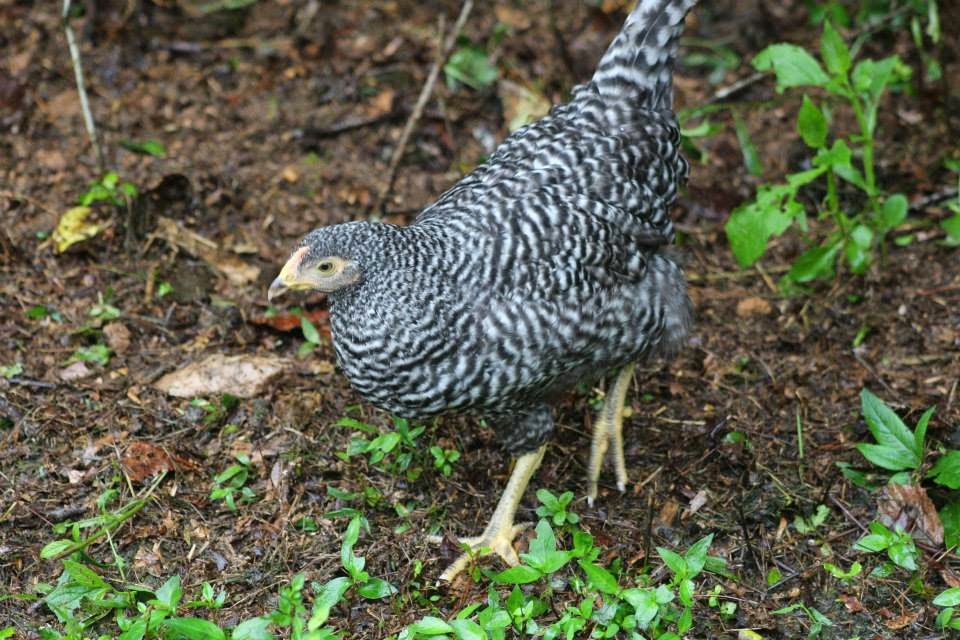Genetic Terms
Here is a dictionary of genetic terms I'll use, throughout this article and later articles. If you come across a word you don't know, come here and you might find it and its definition. Have at it!Allele:
One of 2 or more forms of a gene that are found at the same place on a chromosome
Chromosome:
A threadlike structure that carries genetic information in the form of genes
DNA:
Deoxyribonucleic Acid, which is the carrier of genetic information
Dominant Gene:
An allele that is dominant, as in it can overpower a recessive gene when the pair is heterozygous.
Genotype:
The genetic makeup (as in a chicken that is o+/o+, which is the genotype of a White Egg Layer - see phenotype)
Heterozygote:
A chicken that is heterozygous for a gene
Heterozygous:
Genes come in pairs, the alleles can either be alike or different. If it is heterozygous, it is different (for instance, O/o+ is heterozygous)
Homozygote:
A chicken that is homozygous for a gene
Homozygous:
Genes come in pairs, the alleles can either be alike or different. If it is homozygous, both alleles are the same (for instance, O/O is homozygous)
Mutation:
When a gene can be changed, like, the mutations of extended black. Like most genes it can either be e+ (duckwing/light brown) or E (extended black), just the same as most other genes. But that gene has mutations - E^R (birchen), E^Wh (Wheaten), and e^b (partridge/brown). The mutations can be in the same gene pair as e+ and E.
Phenotype:
The visual description, what you see when you look at the chicken (as in White Egg Layer, which is the phenotype of a chicken that is o+/o+ - see genotype)
Punnett Square:
A diagram used to show the outcome of a cross between 2 chickens
Recessive Gene:
Recessive genes will only show in a homozygote, if it is heterozygous the dominant gene will overpower the recessive gene and the recessive gene will be hidden by the dominant gene.
Sex-Linked Genes
Ever heard of sex-links? They're hybrids, and you can tell the males and females apart by their color at any age. How does that work? Sex-linked genes. Here's how.In humans there are genes that determine whether you are male or female, most people know about these but they are XX in females and XY in males. This means that your dad determined your gender. In chickens, instead of using X and Y, they have Z and W. It's backwards of humans - the hen determines the offspring's gender, because they are ZW while the roosters are ZZ.
On the right is a diagram. It shows the barring gene (which is sex-linked and how Black Sex-Links work), Silver (which refers to the ground, base color of the bird. A chicken can be silver based or gold based wildtype or "golden", its sex-linked), and Mahogany (which is not sex-linked, for reference).
The green shows the genotype of the two chickens, while the purple labels the gene on the far left and shows the phenotypes. As you can see, the sex-linked genes are those that only have one allele on the hens, while having 2 alleles, as usual, on the roosters.
How to Use Punnett Squares
I would like to introduce you all to George, my imaginary friend the Ameraucana rooster. Secondly, I would like to introduce you to Hannah, my imaginary friend the Barred Rock hen. We are going to breed them, but we want to know what color their eggs will be. Even though George doesn't lay eggs himself, he has genes for eggs. His genes are O/O, which means that he is a blue egg layer. Hannah, on the other hand, has genes that are o+/o+, which means that she is a white egg layer. You see, Barred Rocks lay brown eggs, but brown eggs are actually white eggs, they are just covered in a brown paint called a 'bloom'. Green eggs are actually blue eggs with a bloom over them. So we have George (O/O) and Hannah (o+/o+), and now we want to breed them. To find out what
So we have George (O/O) and Hannah (o+/o+), and now we want to breed them. To find out whatcolor eggs their offspring will lay, we have to use a punnett square. George's genotype is on the top, each allele is over its own box. Hannah's genotype is on the left side, and each allele is beside its own box. Then, you look at the alleles touching each box and put them inside the box, making a new gene pair. Since all the new gene pairs are the same, we know that 100% of the offspring will be O/o+. Since blue eggs (O) is dominant, all of them will lay blue eggs.
But what happens if we have two chickens that are O/o+? Lets call them Jim and Lori, and they both have a heterozygous O/o+ genotype. What happens if we breed them? Look at the punnett square to the right to find out. It works the same way this time as it did last time. Breeding Jim and Lori results in 25% of the offspring being homozygous white egg layers, 50% being heterozygous blue egg layers, and 25% being homozygous blue egg layers.
~
Please comment below! Follow me on Google+ in the upper right and g+1 me at the top left on the bar! May you have a wonderful day full of chickens.



.JPG)






